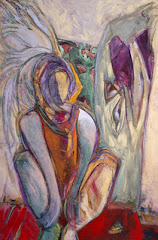 Through his giant earthwork, Spiral Jetty, Robert Smithson helps us to see the world in a new or innovative way. He sheds light on a remote destination, which many people would not have been fortunate enough to experience otherwise. His landscape expresses much more than the photograph taken by Sandy Brooke ever could, although its remote location makes viewing it slightly difficult. His unique depiction promotes thoughtful insight into the ways in which the spiral links many cultures of the world. The location of his artwork similarly represents this idea of bringing different people together, being that it is the spot in which the first transcontinental railroad rails were joined. The contradictions (which were brought up in the text) that the spiral represents around the world are new to me. However, they are quite real and thought provoking. Smithson was a true genius, highlighting so many contradictions in a single work of art. The monstrosity of his earthwork brought the worlds attention to a small place in Utah, again connecting the different cultures’ attention to a single place.
Through his giant earthwork, Spiral Jetty, Robert Smithson helps us to see the world in a new or innovative way. He sheds light on a remote destination, which many people would not have been fortunate enough to experience otherwise. His landscape expresses much more than the photograph taken by Sandy Brooke ever could, although its remote location makes viewing it slightly difficult. His unique depiction promotes thoughtful insight into the ways in which the spiral links many cultures of the world. The location of his artwork similarly represents this idea of bringing different people together, being that it is the spot in which the first transcontinental railroad rails were joined. The contradictions (which were brought up in the text) that the spiral represents around the world are new to me. However, they are quite real and thought provoking. Smithson was a true genius, highlighting so many contradictions in a single work of art. The monstrosity of his earthwork brought the worlds attention to a small place in Utah, again connecting the different cultures’ attention to a single place. Smithson also touches on the idea of change. For, even though this is a man-made landscape, it has been put out to survive the weathering of nature. This spiral is at the mercy of the Great Salt Lake, America’s Dead Sea as it quickly learned after it’s completion. The Jetty was submerged by the rising water level and forced to remain hidden and isolated for over thirty years. It continually undergoes weathering and transformation, as do most object in nature. With this constant change, I can link the many different cultures of the world. For we all are forced to adapt and change in order to survive the pressures of success, change and competition. We are all at the mercy of constant reformation and adaptation, as is the Jetty.
Smithson, Chen and Bierstadt all touch on the four traditional roles of the artist, more or less. Each creates a visual image that allows viewers to imagine a world beyond their front door or their small town. It opens their eyes to the idea of infinite possibilities and a world that has yet to be discovered. They help to turn ideas and thoughts into tangible pieces of art. They all use their creativity, to courageously depict a scene that is put under the discretion and criticism of viewers from around the world.
Their works have much in common, being that they are all scenes of nature. However, there are also many differences. Smithson created a work of art in nature. His artwork is not something that formed naturally. He used his discretion to disturb nature and impose his creativity into the Great Salt Lake. He used the low water levels as his ammunition to leave his mark on the world. Although it soon fired back, proving that nature will always overpower man, submerging his hard work and creativity for over three decades. The other two artists, Chen and Bierstadt simply replicated an already existing scene in nature, intermittently imposing their own interpretations into their artwork. Bierstadt used a more traditional vision, keeping somewhat true to the colors, details and formations of The Rocky Mountains. Although one can closely depict a landscape, it is inevitable that each and every artist will reflect their personal feelings in their artwork. Chen, on the other hand, used a more simple approach, touching only on the basic formations found in his landscape of The Central Mountain. His artwork appears dull and bland, although it means much more to his Chinese culture.
Through the artwork of these three great artists I have grasped a greater understanding and appreciation of the roles art plays in our past, present and future. The ways in which art can capture an audience that can be so different and bring them to a common understanding or liking of a single piece of artwork is truly magnificent. Art has played a significant role in the world that we live in, constantly bringing different cultures together. As I learned earlier about the contradictions depicted in Smithson’s spiral formation, it is only through the true beauty of art in which a world that is vastly diverse can come together and gain a similar admiration for an individual work of art.

















1 comment:
Hi! Mandy
Beautiful picture of the Spiral Jetty. Definitely a place to visit some day!
Post a Comment